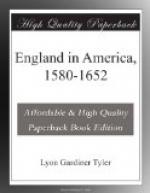So far as the law of England stood at that time, the effect of the dissolution of the London Company was to extinguish the debts of the corporation and vest all its property undisposed of in the crown. On the other hand, there were the repeated official pledges of Charles and his father not to disturb the interest of either planter or adventurer in any part of the territory formerly conveyed by the charter of 1609.[4] Nevertheless, the king preferred law to equity, and October 30, 1629, granted to Sir Robert Heath the province of Carolana in the southern part of Virginia, between thirty-one and thirty-six degrees.[5] But there was a clause in this charter excepting any land “actually granted or in possession of any of his majesty’s subjects.”
About the same time Cottington, the secretary of state, was directed to answer Lord Baltimore’s letter written from Newfoundland and promise him “any part of Virginia not already granted.” Lord Baltimore arrived in London soon after this letter was written, and in December, 1629, petitioned to be permitted to “choose for his part” a tract south of James River and north of Carolana. A charter was made out for him in February, 1631, and would have passed the seals but for the intervention of William Claiborne, one of those Virginia councillors who had offered the oath to Baltimore.[6]
William Claiborne, the second son of Sir Edward Claiborne, of Westmoreland County, England, went over to Virginia with Governor Wyatt in 1621 as surveyor-general of the colony. Shortly afterwards he was made a councillor, and in 1625 secretary of state of the colony. In the Indian war, which began with the massacre in 1622, he was appointed general, and in 1629 received lands in the Pamunkey Neck for valuable military service. Active and fearless, he engaged with great success in the trade for furs in the bay, and was recognized as the foremost man in Virginia. Sent in May, 1630, by the Virginia council to watch the movements of Lord Baltimore, he co-operated in England with ex-Governor Francis West, of Virginia, Sir John Wolstenholme, and other gentlemen who wished the restoration of the London Company.
Aided by these friends, Claiborne defeated the proposed grant, but Baltimore persevered, and, in April, 1632, received from the crown a patent for a portion of the Virginia territory lying north of Point Comfort, and having for bounds the ocean, the fortieth parallel of north latitude, the meridian of the western fountain of the Potomac, the southern bank of the Potomac River, and a line drawn east from Watkins Point. In the grant the land was described as “hitherto unsettled and occupied only by barbarians ignorant of God.” The king first proposed to call it Mariana, in honor of his wife, Henrietta Maria, but on Baltimore objecting that it was the name of a Spanish historian who had written against the doctrine of passive obedience, Charles modified the appellation, and said, “Let it be called Terra Mariae—Maryland."[7]




